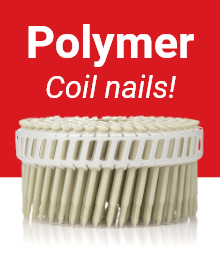General information on finishing of fasteners
Fasteners come in a variety of finishes:
- Bare iron
- Galvanized
- Galvanized
- Stainless steel
- Aluminum
- Plastic (our range of plastic fasteners can be found at polymerfasteners.com)
These different finishes make fasteners more or less corrosion resistant or give them special properties for certain applications.
Fasteners with a clear finish have no protective coating and are the cheapest. However, they do rust faster than fasteners with a protective coating. They are suitable for applications that do not require protection, such as pallets intended for one-time use.
The way to protect fasteners from rust is to galvanize or zinc coat them. Zinc does not protect the steel of nail, for example, but forms a layer that corrodes before the steel corrodes. The thicker the zinc layer is, the longer it takes for the steel to corrode. The thickest layer is called "hot-dip galvanized. The layer is applied by dipping the fasteners into a bath of molten zinc. The protection of galvanization is indicated in microns (one micron equals 0.000001 meters). The thicker the coating is, the better protected the fastener is.
Stainless steel is used in applications where maximum protection is required and the other finishes are not sufficient. Examples of applications are guard rails along highways or applications exposed to (salt) water, where it is critical that the fasteners last a long time.
Not many aluminum or plastic fasteners are available, but they do offer some advantages.
When a wood weld needs to be held in place and cut later, aluminum and plastic fasteners are better suited. Aluminum and certainly plastic are softer and therefore less (aluminum) or not (plastic) debilitating to the joiner's/fabricator's saw blades and machinery.
Plastic materials are also great for holding CNC material. Since aluminum and plastic are softer, they cannot be made into longer fasteners, nor are they suitable for use in certain hardwoods. However, its low weight can be an advantage, and in addition, aluminum fasteners are more rust-resistant than galvanized fasteners and plastic does not suffer from this at all.
General information about staples / staples
All staples / staples are essentially the same. Namely, they consist of a metal wire bent into a specific U-shape.
- The upper part is called the crown.
- The two parallel parts on the sides that protrude through the material are called the legs.
- The end of each leg is called the tip.
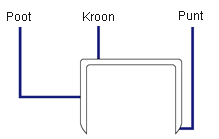
The crown determines which device you can use to hammer the staple or staple into the material. In fact, each device is usually rated for one crown width.
The leg length depends on the application, such as the bonding force, thickness of the materials, etc. Many devices have adjustable length settings.
The points are usually chisel points, but in applications requiring high bonding force, staples with divergent points can be used, so-called spread staples. These are specially cut points that run the legs in an arc rather than straight into the material.
A staple or staple with legs that are not parallel is much harder to pull out than one with parallel legs.
When the designation staple or staple is used depends on the crown width combined with the thickness of the wire. Generally, a crown width of 10 mm or more combined with a wire thickness of 1.00 x 1.25 mm or thicker is referred to as a staple.
General information about nails:
There are three types of nails:
- Coil nails
- Strip nail
- Finishing nails (group that includes brads, pins and T-nails)
Nails (also known as nails) consist of three main elements. The combination of these elements, along with the finish, determines which bonding applications the nail is suitable for.
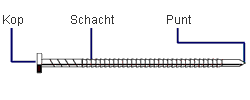
The head:
The head is the part of the nail on which the hammer or, in the case of pneumatic bonding devices, the striking pin of the device strikes down. The head is round, pinched or eccentric.
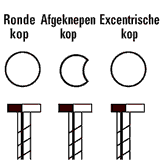
Round-headed nails have a round head. They resemble the nails available loose at the hardware store. They are assembled into a roll or strip so you can use it multiple times without having to reload it after each nail.
All roll nails have a round head.
Not all strip nails have a round head.
Nails with pinched or eccentric heads are always joined together to form strips. In this process, the shafts of the nails sit against each other. This allows more nails to fit in the device so you can use the tacker multiple times without having to reload.
Most roundhead strip nailers have a capacity of 50 nails. Most strip nailers for pinched-head nails have a capacity of 75 nails. However, the number of nails per load always depends on the length of the magazine and the diameter of the nail shafts.
There is little difference between the bonding strength of round-headed nails and nails with pinched heads. The bonding strength is largely in the shaft. The head contributes only when the shank begins to slip out of the wood. The head prevents the top layer of the material from beginning to loosen the bottom layer. Sometimes, when the top layer is weaker than the bottom layer, the head is pulled through the top layer. The force required to do this is much the same for round-headed nails as for nails with pinched heads.
Finishing nails and brads have rectangular heads. The head is the same width as the shaft, but it is deeper than the shaft. As a result, they have greater bonding strength. However, less force is required to pull the head through the top layer than nails with larger, round or pinched heads.
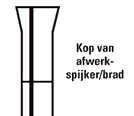
Different nails have different head sizes, depending on shank diameter and application. For a nail with a small shank diameter and a large head diameter, the head would easily detach from the shank. Also, the larger the head diameter is, the fewer nails will fit on a roll or strip. However, there are certain applications that require a very large head diameter, such as for roofing shingles. Such nails for roofing applications have a head diameter of 10 mm so that they hold the shingles (roofing shingles) securely and prevent them from cracking in strong winds.
The shank
The shank is the part of the nail that provides almost all the bonding force. The shank is forced between the wood fibers, where the fibers press against the shank. This pressure makes it difficult to pull nails out of wood.
There are four types of shanks: smooth, spiral, ringed and screwed.
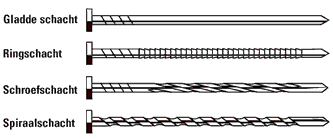
Smooth-shanked nails, as the word implies, have a smooth finish. Because they are smooth, these types of nails are quick to manufacture and therefore the cheapest. However, they have the smallest bond strength. They require less striking force and generally consume less air per nail. Sometimes they can be used in conjunction with a smaller device.
Spiral-shanked nails have either a tapped finish (like a screw) or a spiral finish. Either way, the purpose of the deformed shank is to increase the force needed to pull the nail out of the wood. The wood fibers wrap around the deformed shank, and the different diameters of the shank provide greater bond strength.
In nails with a ring shank, the shank has a series of rings. Again, the different diameters of the shank lead to greater bonding strength. Both ring-shanked and screw-shanked nails are more production-intensive, so they tend to be more expensive than smooth-shanked nails. They also consume more air per nail and require more striking force to drive them into hardwood.
On the other hand, these nails offer greater bond strength than spiral-shanked nails. Of course, this is even more true in larger sizes when you compare nails with ring shank and screw shanks in bonding strength to a nail with smooth shank.
The point
The point of a nail is more important than it appears at first glance. There are points for normal applications and points that prevent wood from breaking.
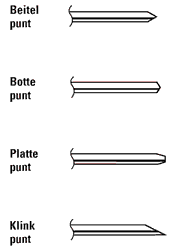
The standard tip for all nails is a chisel point. This is quite sharp and allows the nail to penetrate the wood easily.
To prevent the wood from splitting, there are blunt points and flat points.
